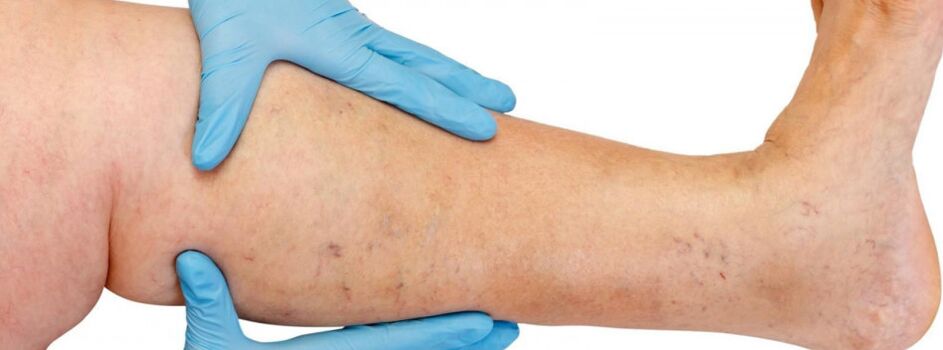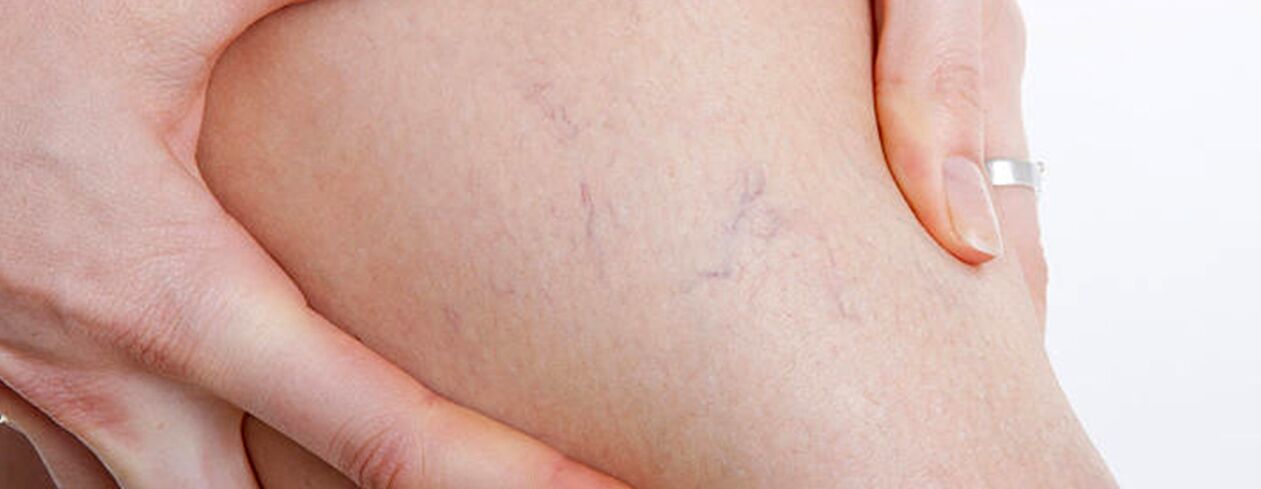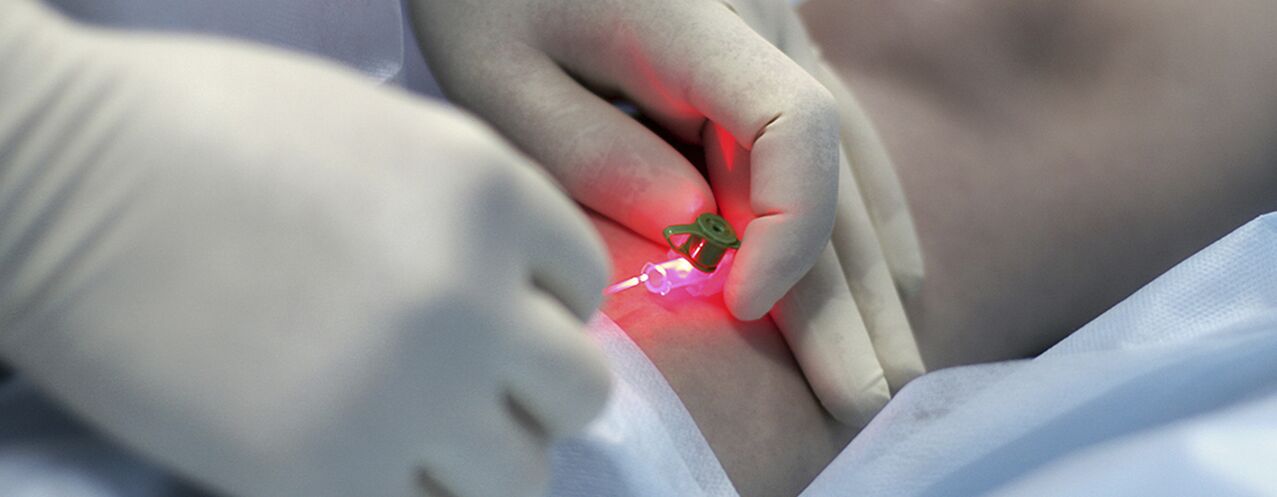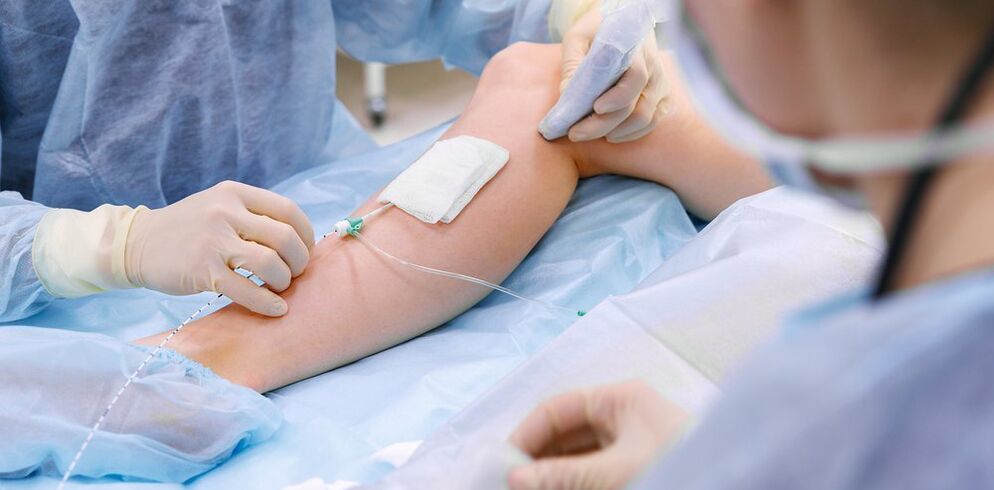
The anatomy of the lower extremity venous system is highly variable. Understanding the individual characteristics of the venous system structure is important for evaluating instrumental data to select the correct treatment.
The veins of the lower extremities are divided into superficial and deep veins. The superficial venous system of the lower extremity originates from the venous plexus of the toes, forming the dorsal venous network and the skin of the dorsal arch of the foot. The medial and lateral border veins originate from it and enter the great and lesser saphenous veins, respectively. The saphenous vein is the longest vein in the body and consists of 5 to 10 pairs of valves, and its diameter is usually 3-5 mm. It originates in the lower third of the calf in front of the medial epicondyle and rises in the subcutaneous tissue of the calf and thigh. In the groin, the great saphenous vein joins the femoral vein. Sometimes the great saphenous vein on the thigh and calf can be represented by two or even three main trunks. The small saphenous vein starts from the lower third of the calf along its side. In 25% of cases, it drains into the popliteal vein in the popliteal fossa region. In other cases, the small saphenous vein can ascend above the popliteal fossa and drain into the femoral, great, or deep thigh veins.
The deep dorsal vein originates from the dorsal metatarsal vein and flows into the dorsal venous arch, where blood flows into the anterior tibial vein. In the upper third of the calf, the anterior tibial and posterior tibial veins join to form the popliteal vein, which is lateral to and slightly posterior to the artery of the same name. In the popliteal fossa, the small saphenous vein, the vein of the knee joint, drains into the popliteal vein. The deep thigh veins usually drain into the femur 6-8 cm below the inguinal fold. Above the inguinal ligament, this vessel receives the epigastric vein, the deep vein that surrounds the ilium, and enters the external iliac vein, where it joins the internal iliac vein at the sacroiliac joint. The paired common iliac veins begin after the confluence of the external and internal iliac veins. The left and right common iliac veins join to form the inferior vena cava. It is a large container without valve, 19-20 cm long and 0. 2-0. 4 cm in diameter. The inferior vena cava has parietal and visceral branches, from which blood flows from the lower extremities, lower trunk, abdominal organs, and small pelvis.
Perforating (communicating) veins connect the deep veins with the superficial veins. Most of them have valves located on the fascia so blood flows from the superficial veins to the deep veins. There are direct and indirect perforating veins. The straight line is directly connected to the deep and superficial venous network, and the indirect connection is indirect, that is, it flows into the muscle vein first, and then flows into the deep vein.
The vast majority of perforating veins arise from tributaries rather than the trunk of the great saphenous vein. The perforating veins on the medial surface of the lower third of the leg are incompetent in 90% of patients. On the calf, the most common failure of the Cockert perforator vein, which connects the posterior branch of the great saphenous vein (Leonardo's vein) with the deep vein. In the middle and lower third of the thigh, there are usually 2-4 most permanent perforating veins (Dodd, Gunther), which directly connect the main trunk of the great saphenous vein and the femoral vein. With deformation of the small saphenous varicose veins, communicating vein insufficiency in the middle and lower third of the lower leg and in the lateral malleolus region is most commonly observed.
clinical course of disease

Basically, varices dilatation occurs in the great saphenous system and less often in the small saphenous system, and starts from the tributaries of the main veins of the calf. The natural history of the initial disease is quite favorable, and the patient may not be bothered by anything other than cosmetic defects for the first 10 years or more. Later, if left untreated, complaints of heaviness, fatigue and swelling of the legs begin to appear during physical exertion (long walks, standing) or in the afternoon, especially in hot seasons. Most patients complain of pain in the legs, but detailed questioning reveals that it is the feeling of fullness, heaviness, and fullness in the legs. Even with brief rest and elevation of the limb, the severity of the sensations is reduced. It is these symptoms that characterize venous insufficiency at this stage of the disease. If pain is mentioned, other causes (insufficient arterial insufficiency of lower extremity, acute venous thrombosis, arthralgia, etc. ) should be excluded. Subsequent progression of the disease, in addition to an increase in the number and size of dilated veins, leads to the development of nutritional disorders, more commonly due to perforating vein insufficiency and deep venous valve insufficiency.
Due to perforating vein insufficiency, nutritional disturbance is limited to any surface of the lower leg (lateral, medial, posterior). The malnutrition in the initial stage is manifested by localized hyperpigmentation of the skin, followed by thickening (induration) of the subcutaneous fat to increase the development of cellulite. The process ends with the formation of ulcerative necrotic defects, which can be 10 cm or more in diameter and extend deep into the fascia. The typical site of venous nutritional ulcers is the medial malleolus region, but the site of calf ulcers can vary and be multiple. During the dystrophic stage, the affected area is severely itchy, burning; some patients develop microbial eczema. Pain in the area of the ulcer may not manifest, although in some cases it can be severe. During this stage of the disease, the heaviness and swelling of the legs become permanent.
Diagnosis of varicose veins
The preclinical stage of diagnosing varicose veins is especially difficult because such patients may not have varicose veins in the legs.
In these patients, the diagnosis of leg varicose veins was falsely rejected despite symptoms of varicose veins, suggesting that the patient had relatives with the disease (genetic predisposition), ultrasonographic data of initial pathological changes in the venous system.
All of this can lead to missed deadlines for optimal treatment initiation, the development of irreversible changes in the vein walls, and the development of very serious and dangerous complications of varicose veins. Prevention of pathological changes in the venous system of the legs with minimal therapeutic effect on varicose veins is possible only when the disease is detected at an early preclinical stage.
Avoiding various diagnostic errors and making a correct diagnosis about the state of the venous system of the leg can only be done after a thorough examination of the patient by an experienced specialist, correct interpretation of all his complaints, detailed analysis of the disease history and access to as much information as possibleof the most modern equipment (instrument diagnostic methods).
Duplex scans are sometimes performed to determine the exact location of the perforating veins, color-coded to clarify veno-venous return. If the valves become incompetent, their leaflets stop completely closing during the Valsava test or compression test. Valvular insufficiency results in veno-venous return, high through the incompetent saphenofemoral fistula and low through the incompetent perforating veins of the leg. Using this method, the reverse flow of blood through the prolapsed leaflets of the incompetent valve can be recorded. This is why our diagnosis is multi-stage or multi-level. Under normal circumstances, the diagnosis is made after a diagnostic ultrasound and examination by a phlebologist. However, in particularly difficult cases, inspections must be carried out in stages.
- First, a thorough examination and interrogation by a venous surgeon;
- If necessary, refer the patient for other instrumental methods of investigation (dual vascular scan, venoscintigraphy, lymphoscintigraphy);
- Invite patients with concomitant diseases (osteochondrosis, varicose eczema, lymphovenous insufficiency) to consult leading expert consultants on these diseases) or other research methods;
- All patients requiring surgery were consulted in advance by the surgical surgeon and, if necessary, by an anesthesiologist.
treat
Conservative treatment is mainly reserved for patients with contraindications to surgery: in general, the veins are slightly dilated, causing only cosmetic inconvenience, if surgical intervention is refused. Conservative treatment aims to prevent further progression of the disease. In these cases, the patient should be advised to wrap the affected area with elastic bandages or to wear elastic stockings, to keep the legs in a horizontal position regularly, and to perform special exercises on the feet and calves (flexion and extension of the ankle and knee) to activate the musculovenous pump. Elastic compression accelerates and enhances blood flow in the deep veins of the thigh, reduces blood volume in the great saphenous vein, prevents the formation of edema, improves microcirculation and contributes to the normalization of metabolic processes in the tissues. Bandaging should begin in the morning before waking up. The bandage has a slight tension from the toe to the thigh and must grip the heel and ankle joint. Each subsequent round of bandages should overlap half of the previous round. Certified therapeutic knitwear should be recommended and the degree of compression selected individually (from 1 to 4). Patients should wear comfortable hard-soled low-heeled shoes and avoid prolonged standing, heavy physical labor, and work in hot and humid areas. If, due to the nature of the productive activity, the patient must sit for extended periods of time, the legs should be elevated and replaced with special braces at the desired height under the feet. It is recommended to walk a little or stand up on your toes 10-15 times every 1-1. 5 hours. The resulting calf muscle contractions improve blood circulation and increase venous outflow. When sleeping, your legs must be elevated.
Patients are advised to limit water and salt intake, normalize body weight, regularly take diuretics, drugs to improve venous tone / drugs to improve tissue microcirculation are prescribed, depending on the indication. For treatment, we recommend NSAIDs.
An important role in preventing varicose veins is physical therapy. In simple form, water programs are useful, especially swimming, foot baths in warm water (not higher than 35°), using a 5-10% solution of table salt.
compression sclerotherapy

The indications for injection therapy (sclerotherapy) for varicose veins are still under debate. The method involves introducing a sclerosing agent into the dilated vein to further compress, disrupt and harden. Modern drugs used for these purposes are quite safe, ie do not cause necrosis of the skin or subcutaneous tissue when administered topically. Some specialists use sclerotherapy for nearly all forms of varicose veins, while others reject the method entirely. Most likely, the truth lies somewhere in between, and for young women in the early stages of their disease, the use of injection therapy makes sense. The only thing is that they have to be warned about the possibility of recurrence (higher than surgery) and need to wear a fixed compression bandage continuously for a long time (up to 3-6 weeks), possibly several times.
The group of patients with varicose veins should include those with telangiectasia ("spider veins") and reticular dilatation of the small saphenous veins, since the causes of these disorders are the same. In this case, together with sclerotherapy, it is possible to performpercutaneous laser coagulation, but only after excluding lesions of the deep and perforating veins.
Percutaneous Laser Coagulation (PCL)
This is a method based on the principle of selective photocoagulation (photothermal decomposition), based on the different absorption of laser energy by various body substances. A feature of this method is the non-contact nature of the technique. Focusing attachments focus energy in the blood vessels of the skin. Hemoglobin in blood vessels selectively absorbs laser beams of specific wavelengths. Under the action of the laser within the lumen of the blood vessel, destruction of the endothelium occurs, resulting in the gluing of the vessel wall.
The efficiency of the PLC is directly dependent on the penetration depth of the laser radiation: the deeper the vessel, the longer the wavelength should be, so the indications for the PLC are rather limited. Microsclerotherapy is most effective for vessels larger than 1. 0-1. 5 mm in diameter. In view of the extension and branching distribution of the spider veins of the legs, the variable diameter of the vessels, a combination therapy is currently being actively used: in the first stage, sclerotherapy is performed on the veins with a diameter of more than 0. 5 mm, and then the laser is used forRemove the remaining "asterisks" of the smaller diameter.
The procedure is almost painless and safe (no skin cooling and anaesthetics are used) because the lightinstrumentRefers to the visible part of the spectrum and calculates the wavelength of light so that the water in the tissue does not boil and the patient is not burned. Pre-applied cream with local anesthetic effect is recommended for patients with high pain sensitivity. Erythema and edema subsided after 1-2 days. After a course of treatment, about two weeks, some patients may experience darkening or lightening of the treated area of the skin, which then disappears. In fair-skinned people, the change is almost imperceptible, but in dark-skinned or tan patients, the risk of this temporary hyperpigmentation is quite high.
The number of procedures depends on the complexity of the case - the depth of the vessels varies, and the lesions may be inconspicuous or occupy a sizable skin surface - but typically no more than four laser treatments (5-10 minutes each) are required. The maximum effect in such a short period of time is due to the unique "square" shape of the device's light pulses, which increases efficiency compared to other devices, while also reducing the likelihood of side effects after surgery?
Operation
Surgical intervention is the only curative treatment for patients with lower extremity varicose veins. The purpose of surgery is to eliminate the pathogenic mechanism (veno-venous return). This is achieved by removing the trunks of the great and small saphenous veins and ligating the incompetent communicating veins.
Surgery for varicose veins has a centuries-old history. Previously, many surgeons still used large incisions during varicose veins, general anesthesia, or spinal anesthesia. The traces after this "veinectomy" remain a lifelong reminder of the surgery. The first surgery on the veins (according to Madelon, according to Schade) was so traumatic that they hurt more than varicose veins.
In 1908, an American surgeon proposed a method of picking the saphenous vein using a hard metal probe with olive and vein picking. In an improved form, this surgical method of removing varicose veins is still used in many public hospitals. The tributaries of the varicose veins are excised through a separate incision, as suggested by surgeon Narat. Therefore, the classic phlebectomy is called the Babcock-Narata method. Phlebcock-Narath phlebotomy has disadvantages - large post-operative scarring and impaired skin sensitivity. The ability to work decreases for 2-4 weeks, which makes it difficult for patients to agree to surgical treatment of varicose veins.
Phlebologists in our network of clinics have developed a unique technique to treat varicose veins in one day. Handling difficult casesCombination technology. Removal of major large varicose veins by inverted peel, which involves minimal intervention through small incisions (from 2 to 7 mm) through the skin, leaving virtually no scarring. The use of minimally invasive techniques involves minimal tissue trauma. The result of our surgery is the elimination of varicose veins with excellent aesthetic results. We perform combined surgery under total intravenous or spinal anesthesia with a maximum hospital stay of up to 1 day.

Surgical treatment includes:
- Cross resection - through the confluence of the main saphenous vein into the deep venous system
- Peeling - removes varicose vein fragments. Only the varicose-converted vein is excised, not the entire vein (as in the classic version).
Actuallyvenule resectionAccording to Narada, it replaces the method of removing the main varicose tributaries. Previously, during varicose veins procedures, skin incisions ranging from 1-2 to 5-6 cm were made through which veins were identified and removed. The desire to improve the cosmetic outcome of interventions and to be able to remove veins not through traditional incisions but through small incisions (punctures) has forced physicians to develop tools that allow them to perform nearly the same procedure with minimal skin defects. This is how phlebectomy "hooks" and special scrapers of all sizes and configurations come in. Instead of using scalpels, which are typically used to pierce the skin, they are starting to use scalpels with very narrow blades or needles that are large enough in diameter (for example, 18G needles for collecting venous blood for analysis). Ideally, the marks of a puncture with such a needle after a period of time are practically invisible.
For some forms of varicose veins, we treat them under local anesthesia on an outpatient basis. Veneectomy is less invasive and less risky to intervene, and it can be performed in a day hospital. Patients can be allowed to go home on their own after minimal observation in the clinic after surgery. During the postoperative period, maintain an active lifestyle and encourage active walking. Temporary disability generally does not exceed 7 days before it is possible to start work.
When is venule resection used?
- Great saphenous vein or small saphenous varicose trunk more than 10 mm in diameter
- After thrombophlebitis in the main subcutaneous cadre
- After trunk recanalization after other types of treatment (EVLK, sclerotherapy)
- Removal of very large individual varicose veins.
It can be a stand-alone procedure or part of a combination therapy for varicose veins, combined with laser vein therapy and sclerotherapy. The application strategy is determined individually, always taking into account the results of duplex ultrasound scans of the patient's venous system. Veniectomy is used to remove veins of various locations that have changed for various reasons, including facial veins. Professor Varady from Frankfurt developed his handy tool and formulated the basic assumptions of modern venule resection. Varadi phlebotomy provides excellent cosmetic results without pain and hospitalization. It's a very hard, almost jewelry job.
after vein surgery
The postoperative period after the usual "classic" phlebotomy is very painful. Sometimes large hematomas are disturbing, with edema. Wound healing depends on the surgical technique of the phlebologist, sometimes lymphatic leakage and visible scarring over a long period of time, usually after large phlebotomy, the sensitivity of the heel area is violated.
In contrast, after venuleectomy, the wounds do not require sutures, as these are just punctures, there is no pain, and no damage to the cutaneous nerves has been observed in our practice. However, only a very experienced phlebologist can obtain such phlebectomy results.
Make an appointment with a phlebologist
Be sure to consult a qualified specialist in the field of vascular disease.

















